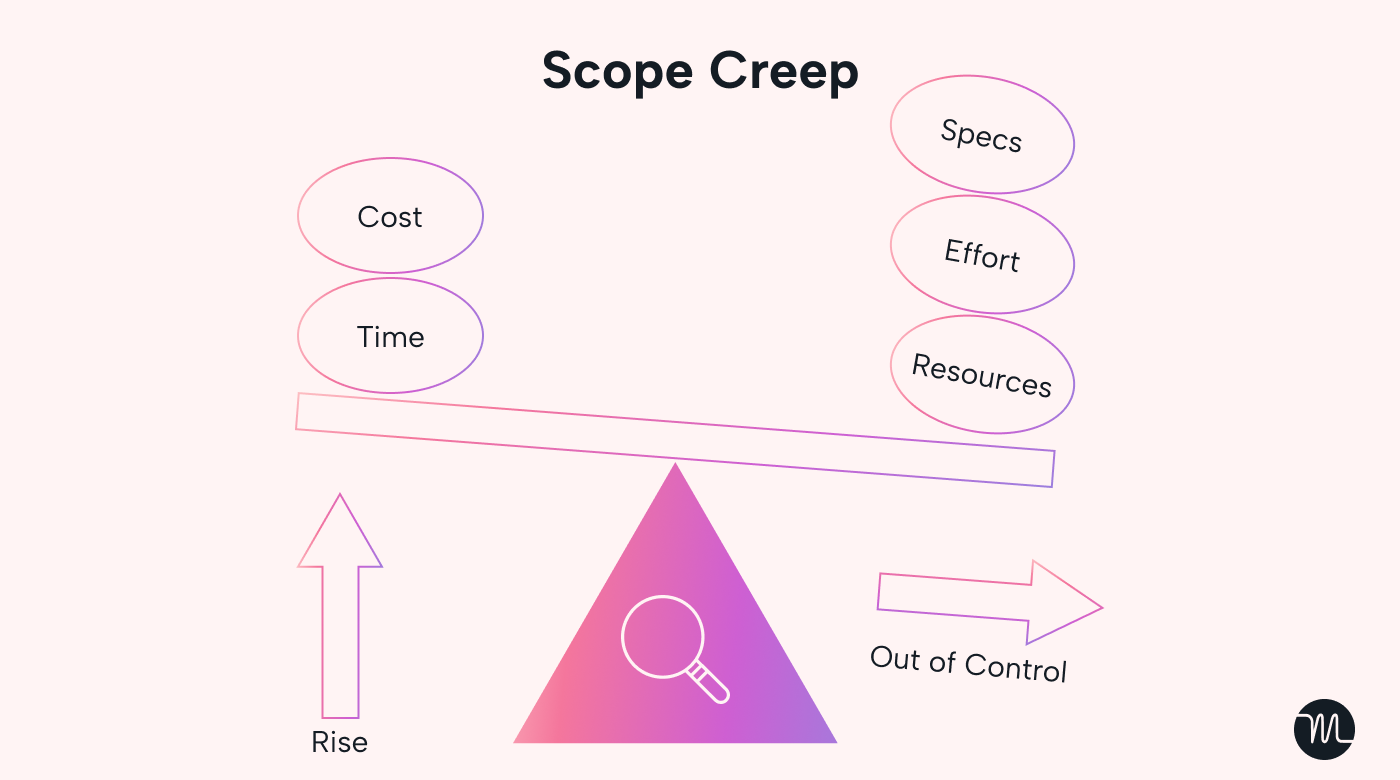You're juggling client requests, managing a team, and keeping an eye on deadlines.
The last thing you need is out of scope tasks threatening to tip the balance.
This article will help you grasp the concept of out of scope, manage it effectively, and turn it into a tool for improved business efficiency.
What does out of scope mean?
Out of scope refers to tasks not part of the original project plan or contract.
Suppose you're baking a cake for a friend, and midway, they ask you to cater a full dinner. This additional request qualifies as out of scope.
What does out of scope mean in business?
Ever heard the phrase out of scope in a business meeting and pondered its real meaning?
Moreover, how it matters to you as a business owner?
Out of scope describes tasks that stray beyond the mutually agreed boundaries of a project or contract.
Let's dissect it clearly: Out of scope crops up when a task comes up during a project, separate from the initial agreement.
Grasping this idea is easier with a real-world example:
Imagine you own a design agency, and a client hires you to design a logo and business cards.
However, halfway through the project, they ask that you also create a website for them.
That isn't part of the original contract — it's out of scope.
In scope vs. out of scope: understanding the difference
Let's clarify the difference between in scope and out of scope work.
In scope includes tasks agreed upon at the project's inception — what's planned, budgeted, and anticipated.
In contrast, out of scope includes unforeseen tasks requested during the project, which must be planned or budgeted.
The cornerstone of a thriving business is setting clear boundaries.
Misunderstandings or miscommunication about in scope and out of scope work can frustrate clients and overworked teams.
But don't worry. Mastering this concept can pave the way for new opportunities.
Leverage out of scope in contracts: safeguard your business
Have you ever started a project with a set budget, timeline, and tasks, only to find unexpected requests piling up, shifting the project's scope?
Say hello to scope creep.
Contracts can be your shield against scope creep. Let's explore integrating out of scope into your contracts to clearly outline project deliverables and boundaries.
What is scope creep?
Before we explore out of scope contracts, it's critical to identify the real enemy here — scope creep.
 |
Scope creep subtly introduces tasks not part of the original project plan.
Triggered by shifting client requirements, mismanagement, or unclear project parameters, it can strain both timelines and resources.
Effective change management is the key to combating this issue. It establishes clear boundaries to control these incremental demands, ensuring the project stays on track.
Change management: contracts for out of scope work
Contracts can serve as your project's compass, clearly marking what tasks don't belong in your project.
These contracts play two important roles:
- They draw the boundary lines, listing what tasks your project will and won't cover.
- They're a safety net, outlining how extra tasks might impact timelines and budgets.
Building effective change management contracts
A well-drafted contract that plans for unexpected tasks can help your business thrive. Here's how to make it work:
- Spell out the project boundaries: Write down what your project will do and what it won't.
- Show the consequences: Clarify that extra tasks may need more time and money.
- Be transparent: Make sure everyone knows and understands the contract.
Contracts aren't just legal documents, but strategic tools for your business. They help everyone see the big picture, control project growth, and reduce stress. A contract that plans for the unplanned can help your team navigate unexpected tasks confidently.
How out of scope affects your business: an in-depth look
The term out of scope might seem like a project management buzzword, yet its implications can negatively affect your business.
Let's examine out of scope effects on your business and learn how to steer them to your advantage.
Out of scope and workload management
Imagine this: Midway through a project, your client throws you an unexpected task not mentioned in the initial project planning. Instantaneously, your team's workload balloons.
 |
This can toss your planned workload into a tailspin. It makes it difficult to manage your workload.
Sudden tasks might result in the following:
- Stressed employees
- Sagging morale
- Plummeting productivity
If not handled efficiently, these out of scope requests can lead to missed deadlines and blown budgets.
The good news? A well-defined change management process can help avoid these pitfalls.
Out of scope in client communications
Ever had a client ask, "Can you just add this small feature?" only for that 'small feature' to become a time-drain? It's a typical out of scope situation in client communications.
Setting clear project limits upfront is crucial to avoid confusion. Use an out of scope clause in your agreements to clarify that additional tasks imply extra costs and time.
Out of scope in software testing: A case study
To illustrate, let's look at a practical scenario.
In the software testing phase, the goal is to confirm that a product functions as designed. However, certain features might be tagged as out of scope — they won't be tested at this stage.
Why is this important?
- It conserves resources by focusing on high-priority features.
- It ensures the project stays aligned with the agreed-upon timeline.
Managing out of scope
Now that you understand out of scope (and its implications), let’s dive into managing the threat of out of scope.
It starts with understanding your client's vision.
Understand the client vision (to avert out of scope)
Invest time to understand your client's vision. This will help minimize surprises, align everyone on the same page, and strengthen the client relationship.
Maintaining a precise, adaptable project scope will help guide your decisions and ensures your work aligns with the project's objectives.
Once you understand the client’s vision, you must continuously manage the project workload to prevent out of scope work from creeping in.
Five tactics to keep out of scope work at bay
Juggling tasks can feel like balancing on a tightrope. Here are five tactics to help you keep your balance:
- Prioritize: Tasks aren’t all made equal. Determine what's most important and tackle those tasks first.
- Delegate: Share the workload. Utilize your team's skillset effectively.
- Communicate: Maintain open lines of communication with your team. Clarity can sidestep confusion and nurture a collaborative spirit.
- Track: Keep an eye on your project's progress. Knowing where you stand can help you pivot to contingency plans as necessary.
- Learn: on the go and post-project. Reflect on what you’ve done well and areas for improvement. Harness these insights to refine your approach for future projects.
Digital tools and templates: navigating out of scope management
Digital tools can be lifesavers for efficiently managing projects (and preventing out of scope tasks).
 |
These tools and templates provide centralized platforms and blueprints for standardizing work, monitoring progress, allocating resources, tracking time, and enhancing communication.
Time tracking tools
These tools allow you to track and gauge your team's time on tasks. This information can be key in pinpointing inefficiencies and areas where out of scope tasks might be creeping in.
Valuable features include:
- Categorization of time by project or task type
- Built-in timers for real-time tracking
- Reports for deep analysis
Collaboration tools
Collaboration tools are critical for maintaining effective communication within your team. Keeping everyone in the loop makes it easier to keep the work within scope and swiftly address any out of scope tasks.
Key features to consider are:
- Real-time messaging
- File sharing capabilities
- Integration with other tools you're already using
Investing in the right digital resources can significantly streamline your out of scope management process.
Project management platforms
These platforms usually include multiple functionalities designed to help you track tasks and boost collaboration.
Commonly included features are:
- Gantt charts for visualizing project timelines
- Kanban boards for workflow organization
- Reporting tools for tracking progress and productivity
Project scope statement templates
Templates are blueprints for common project management documents that can help you save time (and prevent out of scope work). The project scope statement outlines the project's boundaries, clearly defining what's in scope (and what’s out of scope).
Change request templates
Change request templates are used when out of scope needs to be considered for inclusion in the project. These templates detail the out of scope work, the effects of the additional work on time and budget and formalize the change management process.
Project charter templates
A project charter outlines the objectives, key stakeholders, and scope. It acts as a reference point throughout the project and helps identify and keep out of scope tasks from creeping into the project.
Prevent out of scope management and drive business efficiency
When you’re juggling multiple tasks, managing others, and facing shifting deadlines, it can be hard to spot (and prevent) scope creep.
The key is to proactively manage your work, and Motion can help you do so. With its AI capabilities, Motion can identify potential resource conflicts, estimate task durations, and suggest optimal scheduling to manage tasks more effectively.
Take control of your project's scope today? Grab your 7-day free trial.





